Related Research Articles
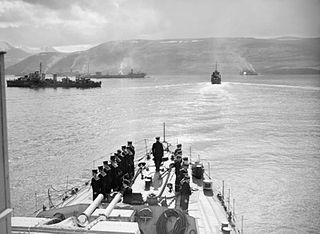
PQ 17 was the code name for an Allied Arctic convoy during the Second World War. On 27 June 1942, the ships sailed from Hvalfjörður, Iceland, for the port of Arkhangelsk in the Soviet Union. The convoy was located by German forces on 1 July, after which it was shadowed continuously and attacked. The First Sea Lord Admiral Dudley Pound, acting on information that German surface units, including the German battleship Tirpitz, were moving to intercept, ordered the covering force built around the Allied battleships HMS Duke of York and the USS Washington away from the convoy and told the convoy to scatter. Because of vacillation by Oberkommando der Wehrmacht, the Tirpitz raid never materialised. The convoy was the first large joint Anglo-American naval operation under British command; in Churchill's view this encouraged a more careful approach to fleet movements.

The Arctic convoys of World War II were oceangoing convoys which sailed from the United Kingdom, Iceland, and North America to northern ports in the Soviet Union – primarily Arkhangelsk (Archangel) and Murmansk in Russia. There were 78 convoys between August 1941 and May 1945, sailing via several seas of the Atlantic and Arctic oceans, with two gaps with no sailings between July and September 1942, and March and November 1943.
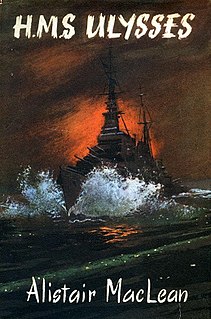
HMS Ulysses was the debut novel by Scottish author Alistair MacLean. Originally published in 1955, it was also released by Fontana Books in 1960. MacLean's experiences in the Royal Navy during World War II provided the background and the Arctic convoys to Murmansk provided the basis for the story, which was written at a publisher's request after he'd won a short-story competition the previous year.

The third USS Rowan (DD-405) was a Benham-class destroyer named for Stephen C. Rowan. Rowan was in the Atlantic when the United States entered World War II, and was one of the United States Navy ships joining the British Home Fleet for the battle of convoy PQ 17. Rowan later engaged French warships in the Naval Battle of Casablanca while supporting Operation Torch. Rowan then defended convoy UGS 6 before supporting the invasion of Sicily. Rowan was sunk by E-boats off Salerno during the allied invasion of Italy.

USS Alfred Wolf (DE-544) was a proposed World War II United States Navy John C. Butler-class destroyer escort that was cancelled before completion.
Convoy PQ 4 was the fifth of the Arctic Convoys of World War II by which the Western Allies supplied material aid to the Soviet Union in its fight with Nazi Germany. The Convoy sailed from Hvalfjord, Iceland on 17 November 1941 and arrived at Archangelsk on 28 November 1941.

Valentin Savvich Pikul was a popular and prolific Soviet historical novelist of Ukrainian-Russian heritage. He lived and worked in Riga.

Pan Kraft was a cargo ship built in 1919 by the Western Pipe and Steel Company of California. She was one of eighteen ships built by the company for the U.S. Shipping Board. After merchant service between the wars, she was to become one of the victims of Great Britain's disastrous Convoy PQ 17 to Russia during World War II.
HMS La Malouine was a Flower-class corvette of the Royal Navy, serving during the Second World War. Originally ordered by the French Navy under the same name, following the fall of France, the ship was seized by the United Kingdom and commissioned into the Royal Navy in 1940. The corvette remained in service until being broken up in 1947.
Rösselsprung was a plan by the German Kriegsmarine to intercept an arctic convoy in mid-1942. It was the German navy's largest operation of its type, and arguably the most successful, resulting as it did in the near destruction of Convoy PQ 17. Ironically, this success was entirely indirect, as no Rösselsprung ship caught sight of the convoy or fired a shot at it. PQ 17's losses were instead due to U-boat and aircraft attacks. Despite not making contact with the convoy a number of the Rösselsprung ships were damaged in the course of the operation, notably the heavy cruiser Lützow, which ran aground in thick fog, necessitating three months of repairs.
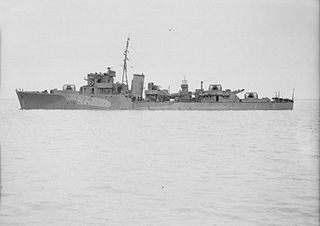
HMS Middleton was a Type II Hunt class destroyer of the Royal Navy and served in the Second World War. Her role was providing support for minelaying operations in the Atlantic and anti-aircraft protection for the North Russian convoys. At the end of the Second World War, Middleton returned to Portsmouth having achieved no less than six battle honours during her brief four years of active service. She remained in reserve until 1955 and was broken up in February 1958.

Empire Baffin was a 6,978 ton cargo ship which was built by Lithgows Ltd, Port Glasgow in 1941 for the Ministry of War Transport (MoWT). She was commissioned in 1943 as HMS Sancroft, being converted into a cable laying ship for Operation Pluto. She was returned to the MoWT in 1946 and subsequently sold and renamed Clintonia. A final change of ownership in 1960 saw her renamed Aspis and she was scrapped in 1963.
Convoy PQ 17 was the penultimate of the PQ/QP series of arctic convoys, bound from British ports through the Arctic Ocean via Reykjavík to the White Sea ports of the Soviet Union, particularly Murmansk and Archangel. The convoy was heavily defended, but fearing an imminent attack by substantial German surface forces, the Admiralty made the decision to disperse the convoy.
Empire Byron was a 6,645 GRT cargo ship which was built in 1941 for the Ministry of War Transport (MoWT). Completed in January 1942, she had a short service career. Empire Byron was torpedoed and sunk on 5 July 1942 by German submarine U-703 while a member of Convoy PQ 17.
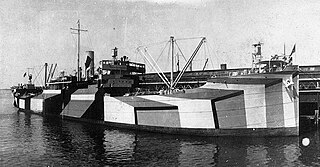
Convoy PQ 14 was an Arctic convoy sent from Great Britain by the Western Allies to aid the Soviet Union during World War II. It sailed in April 1942, reaching Murmansk after air and U-boat attacks that sank one ship, and ice damage that saw 16 vessels returned to port. Seven ships arrived safely.
Convoys PQ 9 and 10 were Arctic convoys sent from Great Britain by the Western Allies to aid the Soviet Union during World War II. They sailed together in early February 1942 and arrived in Murmansk without loss.

Convoy PQ 8 was an Arctic convoy sent from Great Britain by the Western Allies to aid the Soviet Union during World War II. It sailed in January 1942 and arrived in Murmansk with the loss of one escort sunk, and one ship damaged.

QP 14 was an Arctic convoy of the QP series which ran during World War II. It was one of a series of convoys run to return Allied ships from Soviet northern ports to home ports in Britain. It sailed in September 1942 from Archangel in Russia to Loch Ewe in Scotland.
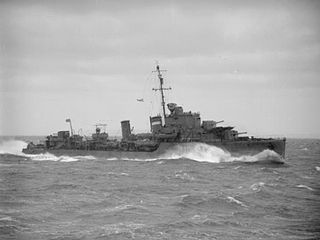
Convoy QP 13 was an Arctic convoy of the PQ/QP series which ran during the Second World War. It was the thirteenth of the numbered series of convoys of merchant ships westbound from the Arctic ports of Arkhangelsk and Murmansk to the United Kingdom, Iceland, and North America.
References
- Пикуль В.С. Реквием каравану PQ-17. Документальная трагедия. — М.: Роман-газета, №9 (991), 1984